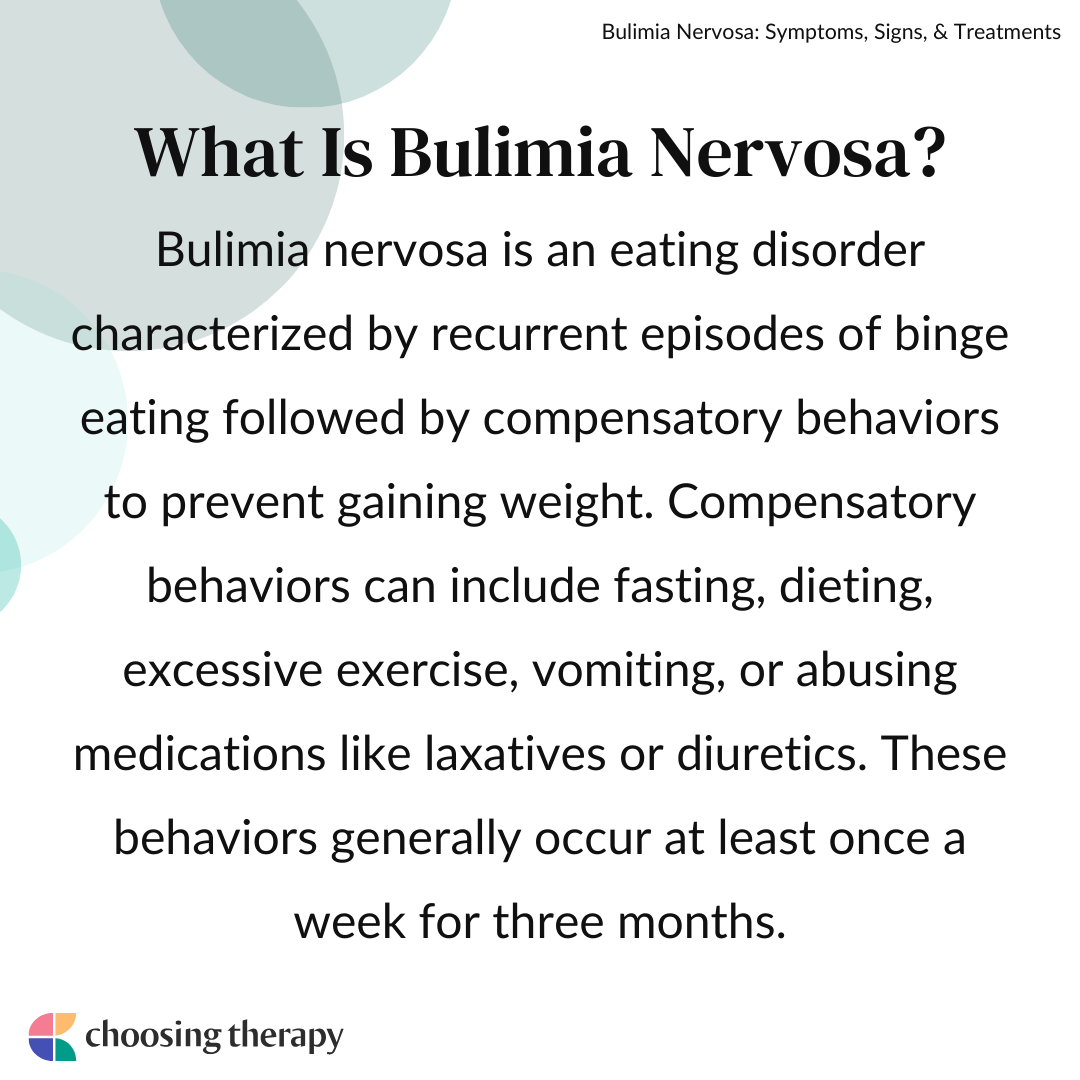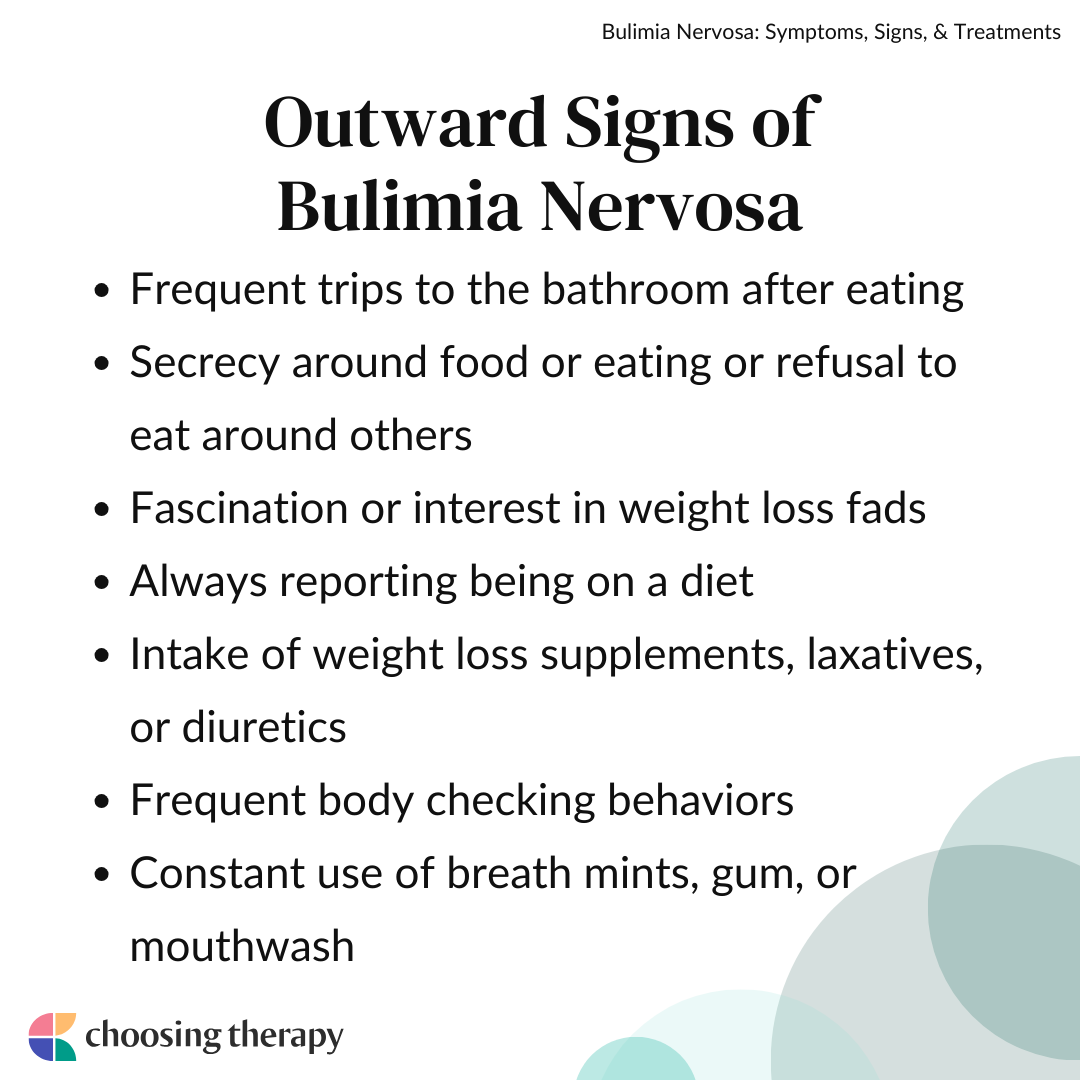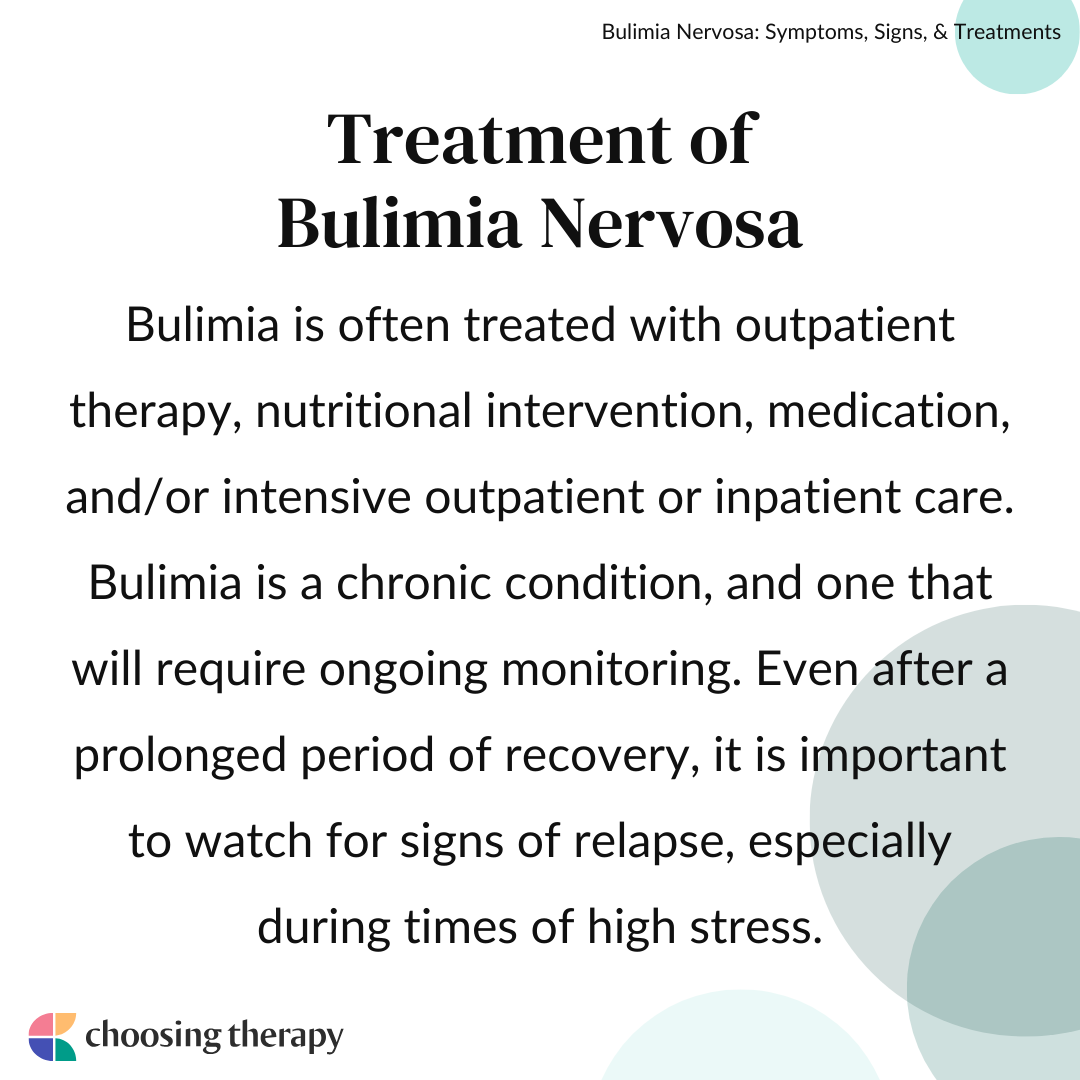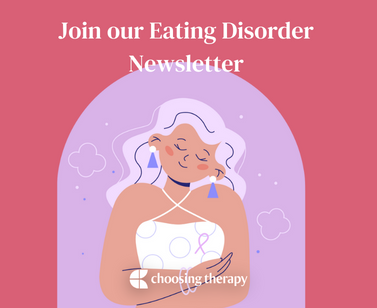Bulimia nervosa is a serious and sometimes fatal mental health condition that involves disordered eating patterns. People with bulimia alternate between eating large quantities of food (binge eating) and engaging in purging activities or behaviors to avoid weight gain. These behaviors are influenced in part by a poor body image or a preoccupation with weight.
Struggling with your relationship with food? Do you find yourself constantly thinking about food or your body? It can be exhausting to have these thoughts. The good news is: you don’t have to feel this way. Take the first step towards healing by taking Equip’s free, confidential eating disorder screener. Learn more
What Is Bulimia Nervosa?
Bulimia nervosa is an eating disorder characterized by recurrent episodes of binge eating followed by compensatory behaviors to prevent gaining weight.1 Compensatory behaviors can include fasting, dieting, excessive exercise, vomiting, or abusing medications like laxatives or diuretics. These behaviors generally occur at least once a week for three months.1
People with bulimia nervosa also have a self-image that is highly influenced by their body shape and weight.1 Bulimia nervosa most commonly begins in adolescence and young adulthood and tends to occur more in females than males with a 10:1 ratio.1 The disorder can be difficult to spot as individuals are generally at a normal or slightly overweight range.1
The Binging & Purging Cycle
The binging and purging cycle occurs in most individuals who have bulimia nervosa. As the binge and purge cycle continues, it has detrimental health effects to the mouth, throat, stomach, and other regions of the body.2 Purging involves expelling food from the body in unnatural ways, such as vomiting, using diuretics, or laxatives. However, there are also non-purging types of bulimia, where a person uses compensatory behaviors like excessive exercise or dieting.
Types of Bulimia
The two subtypes of bulimia are purging and nonpurging. Purging bulimia involves either vomiting or another way to purge, such as misusing laxatives. Non-purging bulimia does not involve the use of purging behaviors, and instead focuses on other ways to restrict food intake.
Purging Bulimia
People with the purging type of bulimia tend to fit within the more stereotyped view of the disorder because they alternate between binging and purging behaviors. Purging can refer to self-induced vomiting, but it can also refer to the laxative abuse or abuse of diuretics or enemas to evacuate the bladder or bowels.
Non-Purging Bulimia
People with the non-purging type of bulimia engage in other “compensatory behaviors” to avoid weight gain after a binge. Compensatory behaviors include restricting food intake and compulsive exercising. People with this subtype do not regularly engage in purging behaviors.
Bulimia Vs. Binge-Eating Disorder
People with binge-eating disorder consume large amounts of food, like those with bulimia, but the primary difference in bulimia versus binge-eating disorder is that people with binge-eating disorder do not purge afterward.
Eating disorders can be challenging to live with.
However, eating disorders are highly treatable. BetterHelp has over 20,000 licensed therapists who provide convenient and affordable online therapy. BetterHelp starts at $65 per week. Take a Free Online Assessment and get matched with the right therapist for you.
Bulimia Symptoms
Mental health conditions are diagnosed by licensed health or mental health professionals. A standard set of criteria is used to determine whether a person has a disorder, and the symptoms and criteria are outlined in the Diagnostic and Statistical Manual of Mental Disorders (DSM-5).
According to the DSM-5, the symptoms of bulimia are:1
- Recurrent episodes of binge eating characterized by both of the following:
- Eating, during a discrete period of time (e.g., within a two hour period), an amount of food that is definitely larger than what most people would eat during a similar period of time and under similar circumstances
- Lack of control over eating during the episode (e.g., a feeling that you cannot stop eating, or control what or how much you are eating)
- Recurrent inappropriate compensatory behavior to prevent weight gain, such as self-induced vomiting, misuse of laxatives, diuretics, or other medications, fasting, or excessive exercise
- The binge eating and inappropriate compensatory behaviors both occur, on average, at least once a week for three months
- Self-evaluation is unduly influenced by body shape and weight
- Binging or purging does not occur exclusively during episodes of behavior that would be common in those with anorexia nervosa
Outward Signs of Bulimia Nervosa
Bulimia causes observable changes in a person’s body, brain, and behavior. Bulimia can be difficult to detect because, unlike anorexia nervosa, people with the disorder may be at or around a normal weight or could be overweight. Bulimia can also be difficult to detect because people with the disorder may eat normal portions of food when they’re around others, only binge eating or purging in secrecy.
Behavior changes are usually the most obvious signs of bulimia, including:
- Frequent trips to the bathroom after eating
- Secrecy around food or eating or refusal to eat around others
- Hoarding of food
- Fascination or interest in weight loss fads
- Always reporting being on a diet
- Intake of weight loss supplements, laxatives, or diuretics
- Frequent body checking behaviors (pinching fat, checking the mirror, etc.)
- Drinking excessive liquids
- Constant use of breath mints, gum, or mouthwash
- Frequent self-critical comments, especially those about weight or appearance
- Consumption of large amounts of food or eating to the point of discomfort
- Emotional eating
Physical changes and health issues that could be warning signs of bulimia include:
- Fluctuations in weight
- Dry skin
- Brittle nails
- Cuts or calluses on tops of fingers
- Dental issues like stained teeth or cavities
- Increased sensitivity to cold temperatures
- Growth of additional body hair
- Thinning hair or hair loss
- Fatigue or weakness
- Trouble sleeping
- Complaints of GI pain or issues
- Missed or irregular menstrual periods
Bulimia Knuckles
Bulimia knuckles are a pattern of calluses around the knuckles or back of the hand, which develop from persistent purging. They are also known as “Russell’s sign.”2 When someone induces vomiting using their hand, their knuckles come into contact with their teeth. This repeated contact is what develops bulimia knuckles or Russell’s sign.
It is important to note that individuals with bulimia nervosa do not always use their hand to induce their gag reflex for vomiting. Sometimes, people use other instruments to trigger their gag reflex. Some individuals with bulimia are also so conditioned to vomiting that they are able to vomit without inducing their gag reflex. Lastly, some people use laxatives or diuretics to purge, which is why bulimia knuckles are not present in all individuals with bulimia nervosa.
Eating Disorder Help
Eating Disorder Treatment That Works – Delivered At Home. Eating disorder treatment is hard – which is why you deserve a team. Equip offers evidence-based care delivered virtually by a five-person care team, so you can achieve recovery without pressing pause on your life. We take insurance! Get a Consultation
Best In-Patient Treatment For Eating Disorders – Find the best local eating disorder treatment center for you. See personalized results and reviews to find the best treatment center covered by your insurance. Start Your Search
Affordable, Online Therapy – Are you or a loved one experiencing eating disorder symptoms? Get help from a licensed therapist. Betterhelp offers online therapy starting at $65 per week. Free Assessment
What Causes Bulimia?
All eating disorders are caused by a complex interaction of biological, psychological, and environmental factors. No singular factor causes bulimia, but some factors do increase a person’s risk of developing the disorder.
Environmental Risk Factors for Bulimia
Some of the social and environmental risk factors for bulimia include:3
- Being the victim of childhood sexual abuse
- Living in a sorority house
- Being involved in athletic activities
- Being in an occupation that focuses on weight or appearance
- A tendency to eat alone
- Parents who had high expectations or who were highly critical
- Parents who misused alcohol
- Parents who were often unavailable
Biological Risk Factors for Bulimia
Biological, psychological, and personality risk factors include:4
- A family history of an eating disorder
- Childhood obesity
- Early puberty
- Perfectionistic personality
- Low self-esteem
- Poor mood regulation
- Poor impulse control
- Extraversion
- Concern about weight or appearance in teenage years
- Fear of weight gain
- Existing mental health disorder like depression or anxiety
- Personality disorders
- Substance misuse, particularly tobacco, alcohol, and stimulant abuse
Who Is Most at Risk for Developing Bulimia?
Certain populations are also more likely to develop bulimia than others, including:3
- Teens and young adults
- Females
- Gay males
- Caucasian women
- People living in industrialized countries
Frequent Co-Occurring Conditions
Other mental health conditions are common in people who have bulimia nervosa. Co-occurring disorders include bipolar disorders, depressive disorder, anxiety disorders, personality disorders, (specifically borderline personality disorder), and substance use disorders.1,5 Alcohol and stimulant use in individuals with bulimia is around 30%, and often begins as a means to control weight and appetite.1
Common comorbid disorders with bulimia include:
- Bipolar disorder
- Anxiety disorders, like panic disorder
- Obsessive-compulsive disorder
- Major depressive disorder
- Specific phobias
- PTSD
- ADHD
- Alcohol use disorder
- Drug abuse and related disorders
Bulimia Health Risks
Doctors and other medical providers are sometimes the first to identify signs of an eating disorder during other routine appointments with their patients. Eating disorders like bulimia place a large amount of stress on the body and can cause several health complications, including acid reflux, dehydration, heart issues, and more.
Health risks of bulimia can include:6
- Dehydration
- Electrolyte imbalance
- Tooth decay or missing enamel
- Acid reflux
- Cough or sore throat
- Esophageal ulcers, erosion, or ruptures
- Tachycardia
- Hypotension
- Orthostasis
- Heart arrhythmias
- Increased instances of miscarriage
- Gastrointestinal injury and complication from long term laxative abuse
Do you have a dietitian on your eating disorder recovery team? Nourish dietitians have experience with Binge Eating, Anorexia, Bulimia, and AFRID. Covered by insurance. 94% of Nourish patients pay $0 out of pocket. Visit Nourish
How Is Bulimia Diagnosed?
During the assessment process, a clinician will also specify which subtype of bulimia a person has, either the purging or non-purging type. The severity of bulimia varies, ranging from mild to extreme. Severity is determined by a clinician and depends on the average number of times a person reports purging or engaging in other compensatory behaviors.
Severity of bulimia is diagnosed using the following guidelines:
- Mild bulimia: An average of 1-3 purging/compensatory behaviors per week
- Moderate bulimia: An average of 4-7 purging/compensatory behaviors per week
- Severe bulimia: An average of 8-13 purging/compensatory behaviors per week
- Extreme bulimia: An average of 14 or more purging/compensatory behaviors per week
Treatment of Bulimia Nervosa
Bulimia is often treated with outpatient therapy, nutritional intervention, medication, and/or intensive outpatient or inpatient care. Bulimia is a chronic condition, and one that will require ongoing monitoring. Even after a prolonged period of recovery, it is important to watch for signs of relapse, especially during times of high stress.
It is recommended that people make treatment decisions in collaboration with a licensed health or mental health professional. This increases the likelihood of being matched with treatment that makes the most sense for you, your budget, and the severity of your symptoms.
Options for treating bulimia include:
Outpatient Counseling
Typically, outpatient counseling occurs with a licensed therapist, counselor, or psychologist in office settings. Sessions may vary in frequency and length, but the average is once- or twice-weekly sessions that last about an hour. Sessions might be conducted individually or with family members or other support people, depending on the individual needs and preferences of the client.
Therapists differ in their training and treatment approach, and many approaches could be effective. The therapies that currently have the most research for effectively treating eating disorders are enhanced cognitive behavioral therapy (CBT-E) and family-based treatments like the Maudsley Method.7
Nutritional Intervention
In many cases, nutritional intervention is recommended in addition to other forms of treatment for eating disorders. Nutritional guidance should be provided by a registered dietitian (RD) who is well-versed in the treatment of eating disorders. The particular recommendations the dietitian makes will vary depending on an assessment of the client’s current weight, health, and nutritional needs.
The involvement of a dietitian helps to ensure that a person in recovery from bulimia is getting their caloric and nutritional needs met in a safe and healthy way.
Medication for Bulimia
In some instances, a doctor, psychiatrist, or other prescribing medical professional will be involved in eating disorder treatment. The purpose of medication may be to address underlying health issues related to or caused by the eating disorder. In other instances, medication may be prescribed to treat other co-occurring mental health conditions. Even for people without existing mental health conditions, antidepressants, particularly SSRIs, have been effective in bulimia treatment.4
Intensive Outpatient & Partial Hospitalization
Intensive outpatient and partial hospitalization programs that specialize in eating disorders are sometimes recommended for people who have more severe symptoms or who are stepping down from inpatient or residential care. These structured programs are offered several days a week for partial or full day treatments and can involve a mix of individual and group therapy, nutritional and medical consults, and other treatment-related activities.
Often, these programs employ an interdisciplinary team that includes registered dietitians, counselors, and doctors. This interdisciplinary team provides more comprehensive wrap-around services to those recovering from eating disorders.
Residential or Inpatient Treatment
In some instances, more intensive treatment is needed. Residential treatments for eating disorders are places where several people can stay for weeks or months at a time while they receive comprehensive treatment. Other inpatient facilities provide more intensive medical monitoring and more comprehensive medical or psychological treatment to higher risk patients.
These facilities are typically similar to hospitals (and sometimes located within a hospital) and involve several doctors and medical professionals who help provide specialized treatment.
Group Therapy & Support Groups
Around a fourth of people who seek treatment for bulimia nervosa are treated with group therapy.8 Group therapy for eating disorders can be a form of intervention added to outpatient psychotherapy, offered during inpatient treatment, or pursued instead of outpatient therapy as a cost-effective approach.18 Research finds that group therapy shows promise in reducing binging and purging behaviors.9
There are a variety of group therapy and support groups available for eating disorders. Some of them are specific to diagnosis, such as groups specifically for bulimia nervosa. Some groups may be led by a therapist and offer psychoeducation components, while other groups may be peer-led and focus more on offering peer-to-peer support rather than education on disordered eating.
Potential Challenges of Bulimia Treatment
Bulimia can be particularly challenging to treat because of the variety of medical issues the binge-purge cycle causes. Complications include electrolyte imbalances, dehydration, cardiac arrhythmias, dental erosions, fluid retention, or esophageal tears.2 Continuing to binge and purge can also affect treatment interventions. For example, antidepressants may not have a chance to be absorbed if someone purges soon after taking the medication.
Additionally, other behaviors such as laxative and diuretic continued use can complicate recovery. Continued use of these medications when being treated for complications related to bulimia can negate good treatment outcomes.
How to Get Help For Bulimia
If you or someone you care about is suffering from bulimia or you suspect you may have an eating disorder, it is important to seek professional help. Speak with your primary care doctor to get a referral or set up an appointment directly by using an online directory or by contacting your insurance provider. You could also use an online eating disorder program like Equip Health or Within Health to get treatment from home.
It is important to find a therapist who has additional training in treating eating disorders. Specifically, finding a Certified Eating Disorder Specialist (abbreviated as CEDS) is recommended. Professionals with this certification have gone through an extensive training and credentialing process with the International Association of Eating Disorders Professionals Foundation.
In addition to consulting with a therapist, it’s also important to follow recommendations of your primary care doctor for any health complications or concerns and to consult with a registered dietitian if recommended. Usually, the therapist you meet with can help to connect or refer you to these providers, and may ask you to sign a release allowing them to communicate with these professionals to help coordinate your treatment.
Eating Disorder Online Support Group Take back control with Relay, the premium binge eating program. Anonymous, flex to your schedule, all in your phone: the tool you need to finally stop binging. Try it free for a week, then subscriptions start at $9.99/month. Learn More.
Living & Coping With Bulimia
People who have bulimia or any other eating disorder are urged to seek professional treatment as soon as possible. Typically, treatment is needed in order to develop healthier behaviors, and also to address the underlying body image issues that are likely driving the disordered eating patterns. Treatment is also sometimes necessary to address health issues that may have resulted from the long-term use of binging, purging, restricting, or misusing laxatives or other medications.
In addition to receiving professional help, people with bulimia can cope in these ways:
- Be completely honest with your treatment team and stick to your treatment plan
- Instead of counting calories, consider eating intuitively—eating when hungry and stopping when full
- Learn to tell the difference between physical hunger and emotional hunger
- Eat slowly, especially when having foods you typically used to binge-eat
- Be honest with doctors and other care providers about your food and exercise habits and any supplements you are taking
- Monitor and moderate stress and treat any co-occurring mental health conditions
- Limit use of social media/other forms of media exposure if you notice it’s impacting you (social media and eating disorders have been seen to be connected, especially for people consuming pro-ana and pro-mia content)
- Consider avoiding tracking calories, food intake, weight, or exercise unless you discuss it with professionals involved in your treatment
- Consult with a registered dietician, nutritionist, and other professionals involved in your treatment prior to engaging in diets or exercise routines aimed at weight loss
- Work on improving your body image and expose yourself to people, messages, and media that promote body positivity
- Practice mindfulness or develop a meditation routine to work on distancing yourself from unhelpful thoughts that feed into your desire to binge, purge, or restrict
- Be proactive about developing healthy lifestyle routines, a strong support system, and an array of strategies that help you maintain your recovery
- Understand what triggers body image issues or impulses to binge, purge, or restrict your intake of food
Bulimia is a chronic condition, and one that will require ongoing monitoring. Even if you have been in recovery for a prolonged period, watch for signs of relapse, especially during times of high stress. Recovery from bulimia is about working to develop and maintain a healthy relationship with food and a healthy view of your body.
Helping Someone Who Is Bulimic
It can be incredibly difficult to support someone with an eating disorder like bulimia nervosa, while maintaining your own self care. Educating yourself on the disorder, keeping personal boundaries, spending quality time together, and seeking your own support can help you keep connected to your loved one as they recover.
Here are tips for helping someone recover from bulimia:
- Seek relevant information on eating disorders through national websites, local resources, podcasts, and doctors.
- Identify and keep personal boundaries, and respect your loved one’s boundaries around their recovery. Decide early on what topics are okay to discuss, what type of support they are okay receiving, and what types of support you are okay to give.
- Attend your own therapy sessions to learn how to support yourself through your loved one’s treatment.
- Sometimes an eating disorder can pervade the relationship so much that it becomes the only thing discussed. Learning to spend quality time with your loved one without discussing food or recovery can help them build a life outside of their relationship to food.
Advice for Parents of Bulimic Children
Supporting a child through recovery can be particularly difficult. Giving your child the dedicated space and time to talk about their needs can help communicate to them that they are safe to ask for help during recovery.
Here are some tips for parenting a child who is dealing with bulimia:
- Ask your child what you can do to help: Children are used to having adults tell them what to do and when. Allowing your child to get a say in their recovery can help promote good self-esteem, prompt conversations, and let them practice advocating for their needs.
- Let them know your concerns but don’t place blame: Blame can prompt feelings of shame that can lead to urges for eating disordered behaviors. Finding a way to communicate your concerns without blaming your child can help avoid making them feel criticized.
- Listen to their feelings and concerns: Listening to your child’s feelings and concerns builds emotional safety necessary for recovery. Reflective listening can be a helpful way to let your child know you are deeply listening to them.
- Schedule regular family mealtimes: Children thrive on routines and structure. Scheduling mealtimes and possibly involving your child in the cooking process demonstrates healthy habits and social functioning.
How to Prevent Bulimia
While there is no way to guarantee prevention of developing bulimia, there are ways to address risk factors and practice healthy habits to mitigate the risk, such as:
- Body positivity in the home
- Positive self talk
- Developing healthy emotional regulation
- Involved parents to promote these positive habits in their children
- Being mindful of diet culture
- Learning about nutrition as a family
- Family meal times
- Not commenting on bodies and weight
What Is the Outlook for Someone With Bulimia?
Most people who seek treatment for bulimia nervosa will recover.2 According to research, 74% of people who seek treatment maintain recovery up to five years later.2 For some people with bulimia nervosa, symptoms can come and go. When symptoms dissipate, this is called remission. Periods of remission that last longer than a year are associated with better treatment outcomes.1
If someone does not seek treatment, consequences can be serious, and sometimes fatal. Complications from routine binging and purging, such as esophageal cancers, nutrient deficiencies, or heart damage, can result in severe medical issues or death.2 Early intervention offers the best treatment outcomes possible for people with bulimia.
Bulimia Vs. Other Eating Disorders
While bulimia can be confused with other eating disorders, it is important to note a few key differences, the biggest being the continuous cycle of binging and compensatory behaviors (like purging).
Bulimia Nervosa Vs. Anorexia Nervosa
The two eating disorders most commonly confused are anorexia nervosa and bulimia nervosa. Alternating between episodes of binge eating and restricting/purging can be a component of both disorders. The primary differentiating factor is that anorexia is diagnosed when the disordered eating behaviors have resulted in significantly low body weight. Someone who displays these behaviors but who is not underweight is more likely to be diagnosed with bulimia.
Bulimia Nervosa Vs. Binge Eating Disorder
Bulimia can be confused with binge eating disorder. Binge eating disorder is another common eating disorder where a person consumes large amounts of food in short periods, similar to bulimia. The difference between bulimia vs. binge eating disorder is that people with bulimia also engage in compensatory behaviors like purging, misusing medications, or excessively exercising. These behaviors are an attempt to cancel out the effects of the binge, avoiding weight gain.
While people with binge eating disorder often feel guilty or disgusted after binging, they do not regularly engage in compensatory behaviors.
OSFED
Approximately 20-40% of people diagnosed with an eating disorder do not meet full criteria for anorexia or bulimia and are diagnosed with an “Other Specified Feeding or Eating Disorder” (OSFED).10 This diagnosis is reserved for people who clearly present with disordered eating patterns that impair their functioning but fail to meet one of the requirements of the criteria for anorexia, bulimia, or binge eating disorder.
An example of a situation where someone with bulimic tendencies may be diagnosed with OSFED is if the binge/purge episodes occur infrequently or if a person purges but does not binge eat.
In My Experience
Additional Resources
To help our readers take the next step in their mental health journey, Choosing Therapy has partnered with leaders in mental health and wellness. Choosing Therapy is compensated for marketing by the companies included below.
Eating Disorder Treatment
Eating Disorder Treatment That Works – Delivered At Home. Eating disorder treatment is hard – which is why you deserve a team. Equip offers evidence-based care delivered virtually by a five-person care team, so you can achieve recovery without pressing pause on your life. We take insurance! Get a Consultation
In-Patient Treatment For Eating Disorders
Find the best local eating disorder treatment center for you. See personalized results and reviews to find the best treatment center covered by your insurance. Start Your Search
Online Talk Therapy
Are you or a loved one experiencing eating disorder symptoms? Get help from a licensed therapist. Betterhelp offers online therapy starting at $65 per week. Free Assessment
Eating Disorders & OCD
Is your eating disorder being made worse by OCD? Almost half of people with eating disorders also have OCD. Intrusive thoughts, including constantly thinking about food or your body, may be a sign of OCD. NOCD Therapists specialize in treating OCD and have an understanding of eating disorders. To learn more about receiving an OCD diagnosis and treatment options, schedule a free 15 minute call. NOCD is covered by many insurance plans. Visit NOCD
Best Online Therapy Services There are a number of factors to consider when trying to determine which online therapy platform is going to be the best fit for you. It’s important to be mindful of what each platform costs, the services they provide you with, their providers’ training and level of expertise, and several other important criteria.
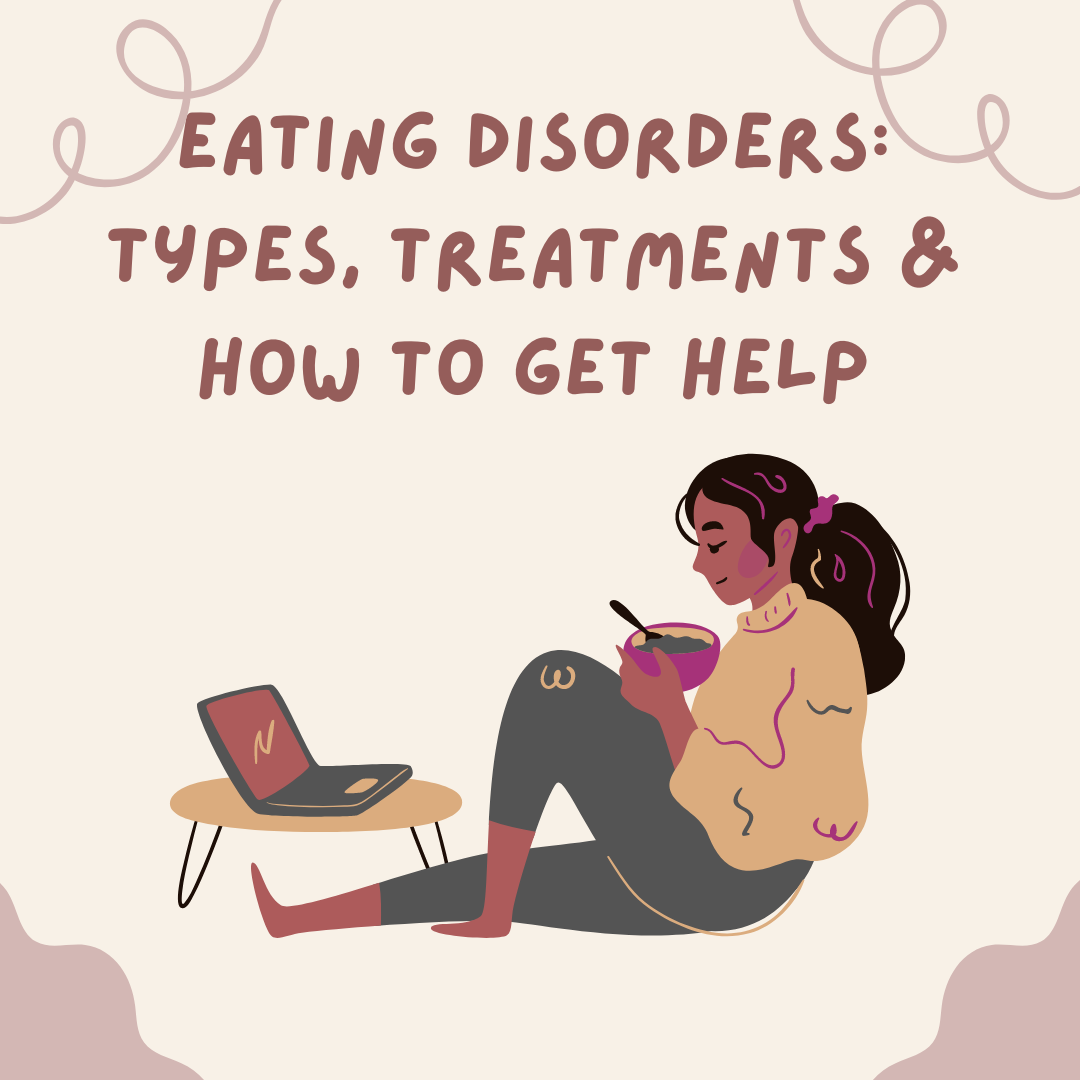
Eating Disorders: Types, Treatments & How To Get Help
If you or a loved one are dealing with an eating disorder, know you’re not alone. Treatment can significantly help improve thought patterns and symptoms that can contribute to eating disorders, and having a robust care team can be an effective prevention strategy long-term.
Find a therapist for eating disorders
Get the help you need from a therapist near you
City or zip Search




